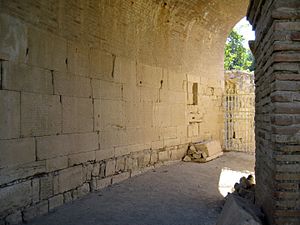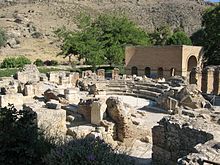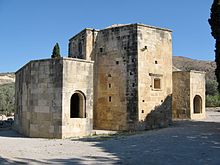Gortyn


Gortyn ( ancient Greek Γορτύν , also Γόρτυνα Gortyna , modern Greek Γόρτυς Gortys ) was an ancient city in central southern Crete , about 40 kilometers south of Heraklion near Agii Deka in the Messara plain . The name possibly goes back to the Urindo-European name * g h ord h for "city".
The excavation site of Gortyn is known for the “Great Inscription” , the oldest legal code in Europe that has been found to date .
history
The different founding myths all refer to the legendary King Minos . In fact, traces of first settlement go as far as the Neolithic ; a Minoan settlement was in the southwestern area of the area. In the Iliad handed down by Homer , Gortyn is mentioned in the second song, line 646 (German translation by Johann Heinrich Voss ):
|
Κρητῶν δ 'Ἰδομενεὺς δουρὶ κλυτὸς ἡγεμόνευεν, |
Crete's people commanded Idomeneus, knowledgeable of the lance: |
At the time of the Dorian immigration , Gortyn became the most important city of the Messara before Phaistos - a walled acropolis dates from this phase. Since the 8th century the city expanded to the areas in the plain in front of the hill of the Acropolis. In the archaic period, the city center was already there with an agora (market square) and a temple of Apollon Pythios. During the heyday of the city-states in the Classical and Hellenistic periods , Gortys, along with Knossos , Eleutherna , Kydonia and Lyktos, was one of the most important and most populous cities on the island with 40,000 to 80,000 inhabitants.
In the 3rd century BC BC the city dominated the southern central Crete without restrictions. 189 BC Chr. Found Hannibal asylum here, although he feared that the Cretans could take his treasure in itself. When Gortyn became involved in the conflict with Rome on its side against Knossos, it became after the Roman occupation of the island (69 BC) from 67 BC. BC to the capital of the Roman province of Creta , later the combined province of Creta et Cyrene , for which, for example, the praetorium , the official seat and residence of the proconsular governor , was built.
The city was a center of Christianization early on : the apostle Paul preached here in 59 AD . In 250 AD, the so-called Ten Holy Bishops are said to have been martyred nearby . The name of the city Agii Deka goes back to this event. In a medieval source, Gortyn was referred to as a bishopric next to Knossos as early as the 2nd century, the first bishop is said to have been St. Titus , a student of the apostle Paul.
After the division of the Roman Empire in 395, Gortyn was added to Byzantium and in the years that followed it was rather a shadowy existence. It became a buccaneer's nest because it was more or less unmolested to operate from Crete. Gortyn had several early Byzantine churches and after the conquest by the Arabs who fled Spain under Abu Hafs Omar (824 or 828), abandoned by its inhabitants, remained important for a while as the only bishopric of Crete. It was not until 961 that the Byzantine general Nikephoros Phokas was able to recapture the pirate island and thus Gortyn. Today's Roman Catholic titular Archdiocese of Gortyna goes back to the former bishopric .
Since 1884 the ancient city has been excavated by Italian archaeologists .
Buildings and sights
- Titus Basilica: ruins of an early Christian basilica from the 6th century; only the altar area of the basilica is still standing, three aisles can be seen. The name of the church was given due to local tradition from its excavators in the 19th century. Since another, older church was discovered in later excavations in Mitropolis, it is now considered questionable.
- Roman Odeion
- Code of Law (the Great Gortyn Inscription): An extensive inscription from the 5th century BC, written alternately from left to right and right to left in a Doric dialect. BC, which is located on the north wall of the Odeion, is considered the oldest legal code in Europe . Amazingly liberal, it contains all the important provisions for common life, such as: B. a marriage and family law .
- Praetorium
- Temple of Apollo
- theatre
- Temple of the Egyptian Gods
- amphitheater
- Circus
- The “Labyrinth” called cave near Gortyn
sightseeing
The excavation site can be visited for an entrance fee, but the area accessible only includes the Titus Basilica and the Odeion, the former being currently (as of May 2018) closed for renovation work. The rest of the extensive area is fenced and inaccessible. Viewing is only possible over the fence.
literature
- Anselm C. Hagedorn: Between Moses and Plato, Individual and Society in Deuteronomy and Ancient Greek Law . Vandenhoeck & Ruprecht, Göttingen 2004, ISBN 3-525-53888-X .
- Andreas Schneider: Crete . 4th edition. DuMont Buchverlag, Cologne 1994, ISBN 3-7701-2767-6 .
- Antonis Vasilakis: Gortyn . Vasilis Kouvidis - Vasilis Manouras Editions, Iraklio 2000, ISBN 960-86623-3-8 .
- I. Baldini et alii: Gortina, Mitropolis e il suo episcopato nel VII e nell'VIII secolo. Ricerche preliminari . In: Annuario della Scuola Archeologica di Atene e delle Missioni Italiane in Oriente 90 (2012) 239-308.
Web links
- Gortyn . In: Website of the Greek Ministry of Culture (English)
- Gortyn . In: kreta-reise.info
- Selection from the legal texts (English)
- The Cretan Labyrinth Cave
Individual evidence
- ↑ Gortyn, Gortyna. www.perseus.tufts.edu, accessed June 25, 2010 .
- ^ Fred C. Woudhuizen : On the Identity of the Indo-European Substrate in Western Anatolia . In: Živa antika. Antiquité vivante . No. 63 . Društvo za antički studii na SRM, 2013, ISSN 0514-7727 , p. 9 (English, online ).
- ↑ Homer: Iliad, Second Canto - Dream, Temptation, Ship Catalog. www.gottwein.de, accessed on February 13, 2011 (lines 645 to 652).
- ↑ Klaus Hylla: The Roman Provinces - Gallia Narbonensis, Cilicia, Creta et Cyrena. In: Meinebibliothek.de. Retrieved January 31, 2010 .
- ↑ Claude Lepelly: Rome and the Empire - The regions of the Empire. Nikol Verlagsgesellschaft, Hamburg 2006, p. 313. ISBN 3-937872-28-0
Coordinates: 35 ° 3 ′ 43.7 ″ N , 24 ° 56 ′ 49 ″ E



